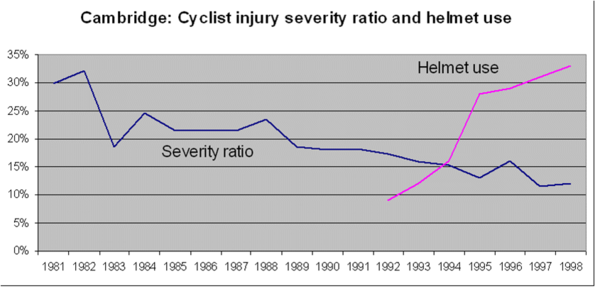Chopper1192":2lrznx7d said:
I would ask what is meant by 'low risk riding'? All riding is low risk until the rider falls off. We're confusing the statistical likelihood of of having an accident or incident, with the risk of injury if one should occur. The likelihood and risk are not interchangeable concepts - the likelihood of an accident on your tow path bimble may be low but the risk of injury if you should fall of is pretty much the same if you fell off at the same speed in your local trail (with the added risk of drowning if you fall the wrong way!)
Sorry, the above does not make sense. Risk = Probability x Consequence
I see the Probability
and Consequence will vary significantly between a 10 Mph tootle on a car free, straight, pot-hole free dry grass lane and a DH run in the Alps on a rock garden and riding on a busy A road in rush our traffic.
The consequence of head impact on jagged rocks or tarmac or through a vehicle windscreen is very realistically not going to be the same as a tumble on grass. It could of course, but I assume we can all agree the seriousness would vary.
The probability of such an event occurring will depend on matters within your control and out of your control. Riding alone for example on a 10 Mph tootle on a car free, straight, pot-hole free dry grass lane we can safely assume the probability of falling on your head will be less than say racing in a group of 250 other cyclists across the peak district on wet tarmac.
These individual thresholds of probability and consequence require a personal and constant evaluation. Does a farmer on a tractor or a milk-man in a delivery van always wear a seatbelt for example? It was mentioned by someone that having children made a new assessment to wear a helmet - clearly the consequence of a fatality as risen (ie caring for an off-spring) albeit the probability is likely to be constant or if anything reduced as a more moderate mode of cycling may come into play.
The effectiveness of a helmet (ie. which one to choose) to handle the foreseen consequence I believe is not adequately researched or tested - even empirical data doesn't seem to help making an informed decision; for example is it actually best to use a full visor motorbike helmet using the "what will do a lot will do a little" approach? Ever thought about horse
riding helmets - I wonder if there is a similar debate raging in that sphere of interest? Thankfully it's threads like these that help to educate and learn the ins-and-outs rather than believing what the Bell marketing men say and evaluating with a critical eye the result of their £1000s investment in lobbying and scare mongering to sell a product.
As for the OP, it's of course good the kid is fine and if there is a belief (medical or not, proven or not) that the helmet worked and is in someway justifiable then so be it.
